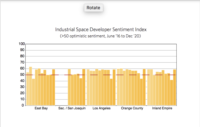Market optimism is ebbing among California’s real estate developers, according to Allen Matkins/UCLA Anderson’s summer/fall 2017 forecast. Office and retail construction is expected to slow, while industrial and multifamily will continue growth.
Although the state’s unemployment has dropped and income and spending are increasing, the drop in optimism about 2020 should lead to a slowing of development, the report says. The biannual survey projects a three-year outlook for California’s commercial real estate industry.
“A lot of people did think it’s a natural progression--California’s been in a recovery for seven years,” says John Tipton, a real estate partner at Allen Matkins.
The sentiment for the state’s office market space continues its downward trajectory due to a lack of confidence in the ability of rents to keep up with inflation. Optimism among office developers in the San Francisco Bay Area, for example, has been trending down for two years and continues to erode. The exception is Los Angeles, where building continues apace, driven by the technology and entertainment sectors, and downtown remains “crane city,” the report says.
Six months ago, it looked as though multifamily development had reached a peak. But California’s continued job and income gains has fueled a rise in multifamily housing construction, with developers seeing opportunities in new projects in every market.
All those jobs and added income, however, won’t necessarily strengthen the retail sector. The growth of e-commerce, while a catalyst to growth for the industrial sector, is predicted to have the opposite effect on retail space. Planned retail projects will be redevelopment of existing space or part of a mixed-use project. Retail developers are also working to create “destination” retail, with entertainment and activities to draw shoppers.
“There’s lot of retail inventory out there. Some of the more traditional strip malls that are really going to be struggling going forward,” Tipton says.
Industrial markets predictions are still very strong with low vacancy rates, the report says, driven by the e-commerce industry’s strong demand for warehouse space. Market sentiment about the next three years has abated somewhat, but vacancies are still extremely low—87 percent of the survey panel started new industrial projects last year and all of them will again this year, the report says. “The industrial sector’s gone from white-hot to red-hot,” Tipton says.
Visit www.allenmatkins.com for the full summer/fall 2017 forecast.



Post a comment to this article
Report Abusive Comment